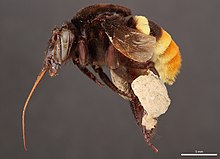| Eulaema | |
|---|---|

| |
| Eulaema cingulata specimen | |
| Scientific classification | |
| Domain: | Eukaryota |
| Kingdom: | Animalia |
| Phylum: | Arthropoda |
| Class: | Insecta |
| Order: | Hymenoptera |
| Family: | Apidae |
| Tribe: | Euglossini |
| Genus: | Eulaema Lepeletier, 1841 |
| Diversity | |
| c. 25 species | |

Eulaema is a genus of large-bodied euglossine bees that occur primarily in the Neotropics. They are robust brown or black bees, hairy or velvety, and often striped with yellow or orange, typically resembling bumblebees. They lack metallic coloration as occurs in the related genus Eufriesea.
Distribution
Eulaema is found from Rio Grande do Sul (Brazil), Misiones (Argentina) and Paraguay to northern Mexico with occasional strays into the United States.
Behavior
Like other euglossine bees, male Eulaema gather and store scents to attract females. Scientists use different mixes of scents to study these bees, including eugenol, cineole, vanillin, skatole and methyl salicylate. However, this list is not exhaustive. After collecting scents, males choose a branch or tree trunk in an area with more open canopy to make their displays. These displays consist of bouts of movement and buzzing before returning to their perch or mating. When they are not foraging and collecting scents, males may reuse refugia, like flowers, for sleeping. Females nest in tree hollows, buildings, or soil banks, with some reports of cooperative nesting. They collect nectar, pollen, and nest building materials such as mud, resin, and fecal matter to provision their young and build nests. Interestingly, scientists report a wide range of social habits in reproductive females. Some live in solitary nests while others live in large groups. One study reported a nest including two different species. There is not current evidence that generations overlap. So, it is unlikely that daughters stay in the nest to help rear more sisters or their own daughters. Despite their behavioral plasticity, Eulaema females are not eusocial. Daughters and sons leave the nest and reproduce separately, starting the cycle anew. While Eulaema generally reproduce year-round, local fluctuations in climate affect abundance and activity. For those interested in learning more, Eulaema meriana is a good species to start with.
Species

- Eulaema atleticana Nemésio, 2009
- Eulaema basicincta Moure, 2000
- Eulaema bennetti Moure, 1967
- Eulaema boliviensis (Friese, 1898)
- Eulaema bombiformis (Packard, 1869)
- Eulaema bomboides (Friese, 1923)
- Eulaema chocoana Ospina-Torres & Sandino-Franco, 1997
- Eulaema cingulata (Fabricius, 1804)
- Eulaema felipei Nemésio, 2010
- Eulaema flavescens (Friese, 1899)
- Eulaema helvola Moure, 2000
- Eulaema leucopyga (Friese, 1898)
- Eulaema luteola Moure, 1967
- Eulaema meriana (Olivier, 1789)
- Eulaema mimetica Moure, 1967
- Eulaema mocsaryi (Friese, 1899)
- Eulaema napensis Oliveira, 2006
- Eulaema nigrita Lepeletier, 1841
- Eulaema parapolyzona Oliveira, 2006
- Eulaema peruviana (Friese, 1903)
- Eulaema polychroma (Mocsáry, 1899)
- Eulaema polyzona (Mocsáry, 1897)
- Eulaema pseudocingulata Oliveira, 2006
- Eulaema quadragintanovem (Nemésio, 2012)
- Eulaema seabrai Moure, 1960
- Eulaema sororia Dressler & Ospina-Torres, 1997
- Eulaema speciosa (Mocsáry, 1897)
- Eulaema tenuifasciata (Friese, 1925)
- Eulaema terminata (Smith, 1874)
References
- Cameron, Sydney A. (2004): Phylogeny and Biology of Neotropical Orchid Bees (Euglossini). Annual Review of Entomology 49: 377-404. doi:10.1146/annurev.ento.49.072103.115855
- Williams, Norris H. & Whitten, W. Mark (1983): Orchid floral fragrances and male euglossine bees: methods and advances in the last sesquidecade. Biol. Bull. 164: 355-395.
- Michener, C. D. (2000). The Bees of the World. Johns Hopkins University Press. 913 pp.
- dos Anjos-Silva, Evandson J.; Camillo, Evandro & Garófalo, Carlos A. (2006): Occurrence of Aglae caerulea Lepeletier & Serville (Hymenoptera: Apidae: Euglossini) in the Parque Nacional da Chapada dos Guimarães, Mato Grosso State, Brazil. Neotrop. Entomol. 35(6) doi:10.1590/S1519-566X2006000600024
- Minckley, R. L., S. G. Reyes (1996). Capture of the orchid bee, Eulaema polychroma (Friese) (Apidae: Euglossini) in Arizona, with notes on northern distributions of other Mesoamerican bees. J. Kansas Entomol. Soc. 69(1): 102-104.
- Bennett, Fred D. (1972). "Baited McPhail Fruitfly Traps to Collect Euglossine Bees". Journal of the New York Entomological Society. 80 (3): 137–145. ISSN 0028-7199. JSTOR 25008817.
- Ferreira, M. G.; Pinho, OC de; Balestieri, J. B. P.; Faccenda, O. (December 2011). "Fauna and stratification of male orchid bees (Hymenoptera: Apidae) and their preference for odor baits in a forest fragment". Neotropical Entomology. 40 (6): 639–646. doi:10.1590/S1519-566X2011000600002 (inactive 1 November 2024). ISSN 1519-566X. PMID 23939269.
{{cite journal}}: CS1 maint: DOI inactive as of November 2024 (link) - ^ Dodson, C. H. (1966). "Ethology of Some Bees of the Tribe Euglossini (Hymenoptera: Apidae)". Journal of the Kansas Entomological Society. 39 (4): 607–629. ISSN 0022-8567. JSTOR 25083566.
- Kimsey, Lynn Siri (November 1980). "The behaviour of male orchid bees (Apidae, Hymenoptera, Insecta) and the question of leks". Animal Behaviour. 28 (4): 996–1004. doi:10.1016/S0003-3472(80)80088-1. S2CID 53161684.
- Pazmiño-Palomino, Alex; De Oliveira, Marcio Luiz (2021-08-14). "First Case of Gynandromorphism in the Orchid-Bee Eulaema meriana (Olivier) (Hymenoptera: Apidae)". Sociobiology. 68 (3): e5778. doi:10.13102/sociobiology.v68i3.5778. ISSN 2447-8067. S2CID 237954029.
- Prŷs-Jones, Oliver (January 2011). "Collection Of Vertebrate Faeces By The Orchid Bee Eulaema cingulata Fabricius". Bee World. 88 (3): 67. doi:10.1080/0005772X.2011.11417421. ISSN 0005-772X. S2CID 85210721.
- Cameron, Sydney A.; Ramírez, Santiago (2001). "Nest Architecture and Nesting Ecology of the Orchid Bee Eulaema meriana (Hymenoptera: Apinae: Euglossini)". Journal of the Kansas Entomological Society. 74 (3): 142–165. ISSN 0022-8567. JSTOR 25086012.
- Wicaksono, Anggun; Atmowidi, Tri; Priawandiputra, Windra (2020-12-31). "Keanekaragaman Musuh Alami Koloni Lepidotrigona terminata Smith (Hymenoptera: Apidae: Meliponinae)". Jurnal Sumberdaya Hayati. 6 (2): 33–39. doi:10.29244/jsdh.6.2.33-39. ISSN 2477-037X. S2CID 233294416.
- Santos, M. L.; Garófalo, C. A. (1994-03-01). "Nesting biology and nest re-use ofEulaema nigrita (Hymenoptera: Apidae, Euglossini)". Insectes Sociaux. 41 (1): 99–110. doi:10.1007/BF01240577. ISSN 1420-9098. S2CID 12298103.
- Ramírez, Santiago R; Hernández, Carlos; Link, Andres; López-Uribe, Margarita M (May 2015). "Seasonal cycles, phylogenetic assembly, and functional diversity of orchid bee communities". Ecology and Evolution. 5 (9): 1896–1907. Bibcode:2015EcoEv...5.1896R. doi:10.1002/ece3.1466. ISSN 2045-7758. PMC 4485970. PMID 26140205.
| Taxon identifiers | |
|---|---|
| Eulaema | |